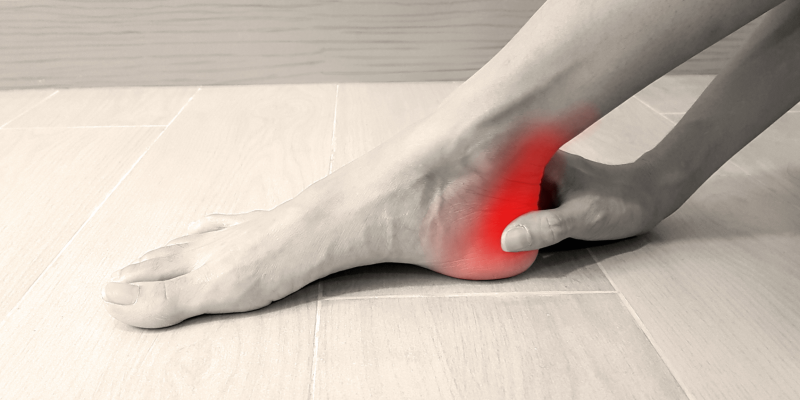Achilles tendon is the biggest and strongest tendon in the body. It is found at the back of the lower leg, just above the heel bone. It attaches your two calf muscles (gastrocnemius and soleus) to the heel bone (calcaneus) and helps you go up onto tiptoes.
Achilles tendinopathy can be described as an insertional or mid-portion, the difference is in the localization. The insertional form is situated at the level of transition between the Achilles tendon and the bone, the midportion form is located 2-7cm above the calcaneus at the level of the tendon body. Depend on the location of the tenson injury, your rehab and recovery time can be differnt.
It is a relatively common soft tissue injury that can affect both athletes and non-athletes. In addition, It is more common in people who take part in sports that mainly involve running; such as football, tennis, volleyball, badminton, and middle or long-distance running. Achilles tendinopathy affects people of all ages and both men and women.
Cause:
What causes Achilles tendinopathy is still not completely understood, but we know tendinopathy occurs when a tendon is unable to adapt to the strain being placed upon it. This leads to repeated small amounts of damage within the tendon fibers and results in the tendon trying to heal itself in response to the strain. Sometimes you will hear this condition called Achilles tendinitis or tendinosis, but these terms are used by people to mean the same thing as tendinopathy.
Risk Factors
Many things affect the load being put through the tendon and It is not simply the result of only exercising too much.
Intrinsic risks:
- 1- Previous Lower limb Tendinopathy
- 2- Age: Achilles tendinopathy is most common from the age of 30 onwards.
- 3- Gender: It is more common in men.
- 4- Weight: If you have a higher than average bodyweight you are more at risk of developing Achilles tendinopathy.
- 5- Diabetes: If you have diabetes you are at an increased risk of developing Achilles tendinopathy.
- 6- Tight and especially weak calf muscles.
- 7- Tight Plantar fascia.
- 8- Poor endurance strength of the calf muscles.
- 9- Poor core stability around the hip/knee.
- 10- Stiff ankle joints. ( Reduced Dorsiflexion)
Extrinsic Risks:
- 1- Training Errors
- 2- Running Mileage (Increasing the mileage quickly)
- 3- Running intensity (Speed, duration, frequency, rest/recovery)
- 4- Old or poor quality footwear.
- 5- Lack of variation in training. (Strength Training / Cross-training)
- 6- Too much hill running.
Symptoms
The most common symptoms that people complain of if they develop Achilles tendinopathy are.
Morning stiffness: Many people complain of stiffness around the tendon when they get up in the morning. This usually eases after a few minutes of walking, but sometimes may last longer.
Tenderness over the Achilles tendon: Often the tendon is very tender to touch when gently squeezed. There may be a tender lump and/or audible clicking from the tendon when you move your ankle.
Variable pain:
Some people can ‘exercise’ through the pain. This means that the pain settles during exercise but after resting it may then increase. Some people experience severe pain from their Achilles tendon which stops them from doing their sport.
Treatment
The management of Achilles tendinopathy in all stages will required load management. Contrary to what most people would assume, complete rest actually worsens the condition and make it harder to return to function later on. In other word, tendons are structures that like the load but the key to a healthy tendon is consistent and appropriate loading.
In an acutely sore tendon, cutting back on load is essential as this allows pain to go away and the tendon to heal. It may involve a change in the sport for a few weeks and reducing running and jumping.
Phase 1:
Physical Therapy:
This may involve several different treatment options including, exercise therapy, manual therapy, and taping technique. Your physical therapist will be rolled out a correct diagnosis, cause, and treatment plan through an objective and subjective assessment.
The first stage of the rehab is reducing pain associated with a reactive tendon. The first 3 steps are managing load, isometric exercises and anti-inflammatory medication. (These steps are crucial to follow).
Managing load:
Managing load is usually involves reducing pain through activity modification and exercise selection. Changing your exercise selection to cross-training, (cycling, swimming, running in water, less hell walking) can help to unload the Achilles tendon. This can take time but we would hope to see some reduction in symptoms within roughly the first 2 to 6 weeks.
Isometric Exercise: (Acute Cases)
Isometric exercises have been shown helpful in reducing pain and also it helps with maintaining muscle strength, and in acute cases can be used immediately. The exercise is calf raises on both feet and hold for 30 to 50 seconds, repeat 3 times and do it at least 2 times per day.
Anti-inflammatory medication (NSAIDs):
You may use (NSAIDs) during the reactive stage of tendinopathy. NSAIDs such as ibuprofen can be helpful to reduce tendon swelling and pain. It’s important to know that the tendon isn’t really inflamed and the long-term use of NSAIDs is not going to help and might even be contraindicated to tendon healing. The research highlighted the NSAIDs would only work in the reactive stage by regulating the activity of tenocytes (cells within the tendon that produce proteins which promote swelling).
Ps: This is a general guideline, and always make sure to consult your GP before taking any medication.
Phase 2:
How long will take you to progress to phase two?
It’s varied for every individual. You will need to review your progress with your physical therapist and depends on your daily symptoms you will modify your exercise intensity.
Once the pain settled the next move is to improve the load tolerance on the muscle and tendon by improving calf muscles strength. As a general guide, you should be able to manage up to 10-15 single leg calf raises with the least increase in your pain while doing the exercise and 24 hours post-exercise.
The calf complex is composed of 2 main muscles (gastrocnemius and soleus) and they both need to be strengthened. The simplest way of achieving this is by doing calf raises from the floor (rather than on the edge of a step). The research highlighted, using an eccentric exercise such as calf raised on the floor and avoiding load the tendon in dorsiflexion will be crucial for insertional Achilles tendinopathy (Read more). You could try this routine for both (gastrocnemius and soleus) and you can discuss with your physical therapist how many sets and reps you should follow.
Exercise Technique:
To perform eccentric heel raises, set the balls of your feet on a step so that your heel hang off the edge. Both feet should point directly forward. Rise up onto the balls of your (non-injured) foot to lift your heel as high as you can. Shift your weight onto both feet and do not bend your knees and slowly lower the heels of the feet still on the step as far down as you can, heels coming below the step. Move with control: take about three seconds to lower the foot. Repeat the steps for 3 sets of 15 repetitions. You will progress this routine after reviewing your symptoms with your physical therapist.
What is Eccentric Exercise?
The eccentric exercise program is the ‘gold standard’ for treatment of this condition. You will usually be seen on a regular basis by your physical therapist to coach you with following this program. The eccentric exercise program is designed to gradually increase the stress going through your tendon in a controlled way; this should gradually reduce swelling and pain.
The eccentric exercises can take between 3 to 6 months to significantly improve your symptoms, but sometimes this can happen more quickly. Approximately 70% of people are able to return gradually to their sport or full activities at around 3 months. Unfortunately, there are no overnight cures for this condition.
There are some important guidelines to observe whilst performing the exercises, that your physical therapist will take you through regarding the eccentric exercise, and what to expect from the routine.
When can you return to sports?
Your physical therapist will guide you on when to return to sport. Ideally, you will gain equal strength left and right with straight and bent leg calf raise.
Some of the don’ts, if you do have acute Achilles Tendinopathy are calf stretching or massaging the tendon. When a tendon is unhappy, direct stretch or compression on the tendon will aggravate it.
What about Steroid Injection?
Up-to-date evidence suggests that steroid injections are not the best treatment option; therefore we do not recommend their use.
FOLLOW US ON YOUTUBE AND GET ACCESS TO OUR WEEKLY FREE REHABILITATION EXERCISES.
Our Approach
Dublin Sports Injury Clinic is a Physical Therapy Clinic based in Fitzwilliam Square, Dublin2. We have a holistic approach to our assessment and treatment. The initial assessment helps us to explore the cause of your injury and help you to get pain free shortly and stop any further injuries. We will design a customized training program for you to start with, and we coach you and monitor your progress closely. We prescribe relative rest or modified activities as required. Depending on the individual requirement, we apply manual therapy accompanied by stretching to restore tissue elasticity and reduce the strain in the muscle-tendon unit with joint motion.
Next step
Want to get in touch with our team of the therapist or you are looking for some advice? Simply fill in your details below & we get in touch with you shortly.
Disclaimer: This article is for information only and should not be used for the diagnosis or treatment of medical conditions. You can contact us if you would like to book an appointment or get some advice from our therapist.


One Response
Thank you for this routine, plantar fasciitis is challenging, but I found this routine really helpful. Thank you